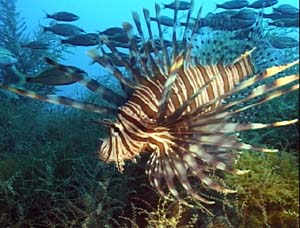| NOAA Magazine || NOAA Home Page |
RESEARCHERS PLAN AUGUST HUNT FOR INVASIVE LIONFISH OFF CAROLINA COAST
 July
16, 2004 — NOAA scientists will lead a diving expedition off the
North Carolina coast August 2-20 to learn more about a venomous predatory
fish whose population appears to be growing in waters along Florida, North
Carolina and Bermuda. The Indo-Pacific
lionfish, Pterois volitans, over the past four years established itself
as the first Pacific marine fish known to populate Atlantic waters, particularly
around reefs off the southeast United States. An aquarium fish popular
for its brilliant colors, the venomous lionfish most likely was introduced
to Atlantic waters by intentional or unintentional releases from aquariums.
(Click NOAA image for larger view of lionfish in the Gulf of Aqaba
in the Red Sea off the coast of Jordan. Click
here for high resolution version, which is a large file. Please credit
“NOAA.”)
July
16, 2004 — NOAA scientists will lead a diving expedition off the
North Carolina coast August 2-20 to learn more about a venomous predatory
fish whose population appears to be growing in waters along Florida, North
Carolina and Bermuda. The Indo-Pacific
lionfish, Pterois volitans, over the past four years established itself
as the first Pacific marine fish known to populate Atlantic waters, particularly
around reefs off the southeast United States. An aquarium fish popular
for its brilliant colors, the venomous lionfish most likely was introduced
to Atlantic waters by intentional or unintentional releases from aquariums.
(Click NOAA image for larger view of lionfish in the Gulf of Aqaba
in the Red Sea off the coast of Jordan. Click
here for high resolution version, which is a large file. Please credit
“NOAA.”)
Scientist Paula Whitfield of the NOAA Center for Coastal Fisheries and Habitat Research, in Beaufort, N.C., will lead the diving expedition sponsored by the NOAA Undersea Research Center at the University of North Carolina at Wilmington to hunt and collect lionfish off the coast to better understand its ecology and its potential impact on native fish communities.
"These beautiful, but unwelcomed, visitors pose potential risks both to people and to their new marine environment," says Whitfield.
 She
cautions that catching a lionfish may cause painful stings from the fish's
neurotoxins and that other fish species can be paralyzed when stung by
lionfish. Most observations of lionfish have occurred in waters more than
100 feet deep. Divers and those fishing in waters at that depth are most
likely to have encounters with the fish. (Click NOAA image for
larger view of lionfish about 40 miles off the North Carolina coast in
140 feet of water taken during the summer of 2001 by Paula Whitfield,
of the NOAA Center for Coastal Fisheries and Habitat Research in Beaufort,
N.C. Please credit “NOAA.”)
She
cautions that catching a lionfish may cause painful stings from the fish's
neurotoxins and that other fish species can be paralyzed when stung by
lionfish. Most observations of lionfish have occurred in waters more than
100 feet deep. Divers and those fishing in waters at that depth are most
likely to have encounters with the fish. (Click NOAA image for
larger view of lionfish about 40 miles off the North Carolina coast in
140 feet of water taken during the summer of 2001 by Paula Whitfield,
of the NOAA Center for Coastal Fisheries and Habitat Research in Beaufort,
N.C. Please credit “NOAA.”)
Lionfish are believed to pose particular risks to the local environment. The invasive lionfish have few if any natural predators in their new Atlantic environment. They are voracious predators that feed on small shrimp and large fishes, including the young of important commercial fish species such as snapper and grouper. These commercial fish use the region's "live bottom" reefs as nursery grounds.
Using deep water SCUBA diving and underwater tools from the NOAA Undersea Research Center at the University of North Carolina at Wilmington (UNCW), the scientists have the following goals:
- Establish baseline lionfish and native fish populations;
- Characterize the ecological role of lionfish to better determine potential risks;
- Evaluate lionfish temperature tolerances to support ecological forecasts of geographic distribution, depth and latitude.
Scientists will use remote camera surveys to estimate lionfish densities and allow year-to-year comparisons. Those surveys also will provide valuable baseline data on native fish diversity. Using known lionfish temperature tolerances and bottom-water temperature data, the scientists hope to more accurately predict potential geographic distribution. They will use lionfish specimens to better understand reproductive status, diet, size, age and other genetic information.
"There's been little research directly examining the impacts of a marine fish in an open marine system," Whitfield said. "We hope our research can lead to improved understanding of the lionfish invasion and its consequences and improve scientific understanding of fish invasions overall."
Scuba divers and others experiencing lionfish sightings are encouraged to contact Whitfield immediately at (252) 728-8714 or paula.whitfield@noaa.gov. She hopes to receive location coordinates, depth information and, if possible, photographs or video. Divers and fishermen should not try to capture fish due to risk of being stung.
NOAA is dedicated to enhancing economic security and national safety through the prediction and research of weather and climate-related events and providing environmental stewardship of the nationís coastal and marine resources. NOAA is part of the U.S. Department of Commerce.
Relevant
Web Sites
NOAA Lionfish
Information
NOAA Center for Coastal Fisheries and Habitat Research
NOAA Lionfish Assessment Report (PDF)
Media
Contact:
Jana Goldman, NOAA
Research, (301) 713-2483